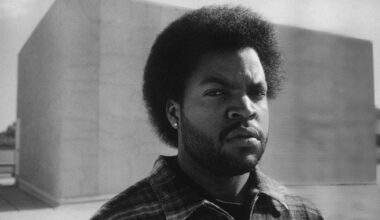The Beekeeper is being hailed as a return to form for both director David Ayer and star Jason Statham, but screenwriter Kurt Wimmer should also receive a fair amount of praise. After all, it was his script that gave life to the idea, and all good movies start with a carefully crafted screenplay. But it also marks Wimmer’s strongest screenplay in a good long while. In the same vein as Ayer, whose struggles on Suicide Squad need no relitigation, and Statham — who came off a major critical and commercial disappointment with Expend4bles — Wimmer was mostly known for his work writing remakes including Total Recall, Point Break and Children of the Corn. None of these lit the world on fire, but Wimmer’s work on The Beekeeper hews close to his 2002 science fiction cult classic Equilibrium, both in terms of action and social commentary.
What Is ‘Equilibrium’ About?
Equilibrium is set in the aftermath of a third World War, which saw the rise of the city-state Libria. Libria’s leader, Father (Sean Pertwee), came to the conclusion that humanity’s capacity for atrocity lay in their ability to feel, and set about eradicating all emotion. Anything that could provoke emotion — books, movies, even works of art — is seized and burned. The population of Libria is placed on a drug called “Prozium” that suppresses their emotions. To enforce its rule, Libria also trains an elite group of warriors known as the Tetragrammaton Clerics, who have mastered the art of “gun kata” — utilizing the “geometric distribution of antagonists” to clear out wide swaths of enemies. One of these clerics, John Preston (Christian Bale), is forced to grapple with his long-buried emotions after he misses a dose of Prozium. Preston then embarks on a mission to bring down Libria, all the while dealing with his attraction towards “sense offender” Mary O’Brien (Emily Watson) and the suspicions of his new partner Brandt (Taye Diggs).
What makes Equilibrium work is its concept, both in terms of intent and execution. The idea of stripping mankind of emotion is explored throughout other science fiction stories, but Equilibrium is interested in exploring Preston’s inner turmoil. He’s haunted by dreams of his wife, who was executed by Libria for being a sense offender. His attraction to Mary comes with a wrinkle, as she was romantically involved with his former partner Partridge (Sean Bean), who Preston killed for a sense offense. Both Brandt and the Clerics’ leader DuPont (Angus MacFadyen) are shown to be blatant sense offenders themselves — using the power they wield as a way to absolve themselves of their hypocrisy. In fact, the opening sequence of Equilibrium sets the stage for this new world perfectly: Preston effortlessly dispatches a group of sense offenders, and discovers that they were hiding a cache of art that includes the Mona Lisa itself. Preston’s response? “Burn it.” Within five minutes, the stakes are set astronomically high — and they only begin to climb when Preston finds himself in opposition with Libria.
‘Equilibrium’ Doesn’t Work Without Christian Bale’s Performance
That leads to the other half of Equilibrium’s secret formula: Christian Bale’s performance. Bale is able to simultaneously convey no emotion and a wealth of it throughout the film, which fleshes Preston out as a character. At the beginning of the film, he is a cold yet efficient killer, able to dispatch anyone who stands in his way — whether it’s a random rebel or his own partner. But once he starts to feel, things change. He fidgets more, he’s unable to come up with answers whenever someone presses him with questions. At the high mark of the film, Preston discovers a treasure trove of forbidden items that includes the work of Beethoven. Once he hears it, he is overcome with emotions. While Bale has delivered plenty of standout performances before, Equilibrium is a perfect display of his talent. He’s also joined by a top-notch cast, especially Diggs — who must have left teeth marks on the set with the way he devoured this role.
You can’t talk about Equilibrium without talking about its action sequences, which are both utterly ridiculous and effortlessly cool. The idea of gun kata is just the type of nonsense a teenage boy would cook up after watching too much anime — in fact, Wimmer actually came up with the concept in his own backyard. But due to Bale’s commitment, the fight sequences transcend the ridiculousness and end up looking immensely awesome. Case in point: when Preston is cornered by other clerics after they discover he’s kept a puppy alive, he manages to dispatch them by shooting his guns in different angles — and hits every single one of his targets. Long before the Mission: Impossible or Fast and Furious films made it their trademark, Equilibrium perfected the art of over-the-top combat.
‘Equilibrium’ Became a Bonafide Cult Classic, Even Inspiring a Comic Miniseries
Upon its release, Equilibrium hit the dreaded one-two combo of being critically panned and bombing at the box office. Most of the criticism lies with how Equilibrium seemed to rip off other works of science fiction, with harsh comparisons being drawn to The Matrix. Wimmer’s response to said criticism didn’t help matters either. “Why would I make a movie for someone I wouldn’t want to hang out with? Have you ever met a critic who you wanted to party with? I haven’t,” he said in an interview.
Time ended up being on Wimmer’s side, as Equilibrium has received reappraisal as a cult classic, with praise being shown for its action sequences, premise, and cast. It even received a sequel in the form of a comic book miniseries, which explored the fallout of the film’s finale: Preston kills DuPont, who had been masquerading as Father, and let a resistance cell destroy the stockpiles of Prozium. This only spurred the Tetragrammaton to make a stronger version of Prozium and weapons to administer it, which led Preston to come out of his preferred solitude. The Equilibrium comic will likely be the only sequel fans receive, as Wimmer has said he has no interest in filming a follow-up.







